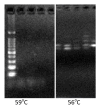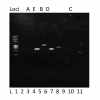Optimization of PCR conditions to amplify microsatellite loci in the bunchgrass lizard (Sceloporus slevini) genomic DNA
- PMID: 21281503
- PMCID: PMC3041990
- DOI: 10.1186/1756-0500-4-26
Optimization of PCR conditions to amplify microsatellite loci in the bunchgrass lizard (Sceloporus slevini) genomic DNA
Abstract
Background: Microsatellites, also called Simple Sequence Repeats (SSRs), repetitions of nucleotide motifs of 1-5 bases, are currently the markers of choice due to their abundant distribution in the genomes, and suitability for high-throughput analysis. A total of five different primer pairs were optimized for polymerase chain reaction (PCR) to amplify microsatellite loci in total genomic DNA of bunchgrass lizards (Sceloporus slevini) collected from three sites in southeastern Arizona; the Sonoita Plain, Chiricahua Mountains and Huachuca Mountains.
Findings: The primers used for current investigation were originally designed for the Eastern Fence Lizard (Sceloporus undulatus). Five primer pairs were selected based on annealing temperatures for optimizing the PCR conditions to amplify with bunchgrass lizards. Different concentrations of DNA and annealing temperature were optimized. While keeping other reagents constant, a DNA concentration, 37.5 ng in the final reaction volume and PCR conditions of an initial denaturation of 94°C for five minutes, an annealing temperature of 55°C and final extension of 72°C for four minutes gave the best amplification for all the primer pairs.
Conclusions: Modifying the standard protocol for annealing temperatures and final extension time increases the success of cross amplification of specific microsatellite loci in the bunchgrass lizard. A loading volume of 5 ul DNA at a concentration of 10 ng/ul and a 2% agarose for gel electrophoresis were observed the best for cross amplification of selected five primer pairs on bunch grass lizard.
Trial registration: The research was conducted with Arizona Game and Fish Department scientific collecting permits SP565256, SP657407 & SP749119 to Dr. Christian A d'Orgeix.
Figures



References
-
- Frankham R, Ballou JD, Briscoe DA. A Primer of Conservation Genetics. Cambridge University Press, Cambridge, United Kingdom; 2004.
-
- Grant PR. Evolution on Islands. Oxford University Press, Oxford; 1998.
-
- Tennessen JA, Zamudio KR. Genetic differentiation among mountain island populations of the striped plateau lizard, Sceloporus virgatus (Squamata: Phrynosomatidae) Copeia. 2008;3:558–564.
-
- Smith HM, Watkins-Colwell GJ, Liner EA, Chiszar D. Sceloporus scalaris auctorum a superspecies (Reptilia: Sauria) Bulletin of the Maryland Herpetological Society. 1996;32:70–74.
-
- Van Denburg J. The reptiles of western North America. Vol. I. Lizards. Occasional Papers of the California Academy of Sciences. 1922;10:1–611.
LinkOut - more resources
Full Text Sources

